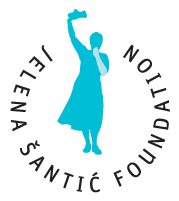
Group 484 founder, Jelena Šantić—whose legacy FJŠ aims to continue—was, by vocation a ballerina, but in life practice, one of the most prominent peace activists both in Serbia and in the countries of the former Yugoslavia. From 1991, she organized many peace demonstrations, initiated numerous NGO-cooperation networks in the country and the region, and was a leader in refugee relief and reconciliation projects among opposition parties.
She was a member of the Belgrade Circle, participating in the founding of the European Movement in Serbia and the Center for Anti-War Action. In 1996, Pax Christi International awarded her the annual Peace Prize for her peacekeeping efforts.
As a prestigious ballerina with an extremely successful career in ballet, Jelena Šantić starred in many productions. She also choreographed for a large number of shows and films. She was a member of CID/UNESCO, Society of Dance History Scholars, ELIA, as well as a contributor to many international and domestic professional journals. She authored a monograph on Dušan Trninić as well as the supplemented edition of the book “Moj život” (My Life) about journalist Maga Magazinović.
In honor of Jelena’s work, Berlin peace activists founded the humanitarian organization, 485. Upon their drive, the Berlin Parliament named a park in the Berlin district of Helersdorf the “Jelena-Šantić-Friedenspark” (Jelena Šantić Park of Peace) on March 18th, 2003—the third anniversary of her passing, which truly came too early. Two years later, on September 23rd, 2005, the former Neimarski park in Belgrade was renamed “Park mira Jelena Šantić” (Jelena Šantić Park of Peace); the park is located in the Belgrade municipality of Vračar, where Jelena lived. On October 18th, 2016, by the initiative of the Vračar Beautification Society, a memorial plaque was erected in Jelena Šantić’s honor.
In 2003, the Belgrade Historical Archive received documents of Jelena Šantić’s life’s work from her family. Seventeen boxes containing: personal documents, notebooks, manuscripts and printed materials, photographs, posters, newspaper clippings, documents of anti-war activities, letters, telegrams, video and audio cassettes, Jelena’s personal belongings and more. (Material range: 1951-2003)
Access a detailed biography here.

